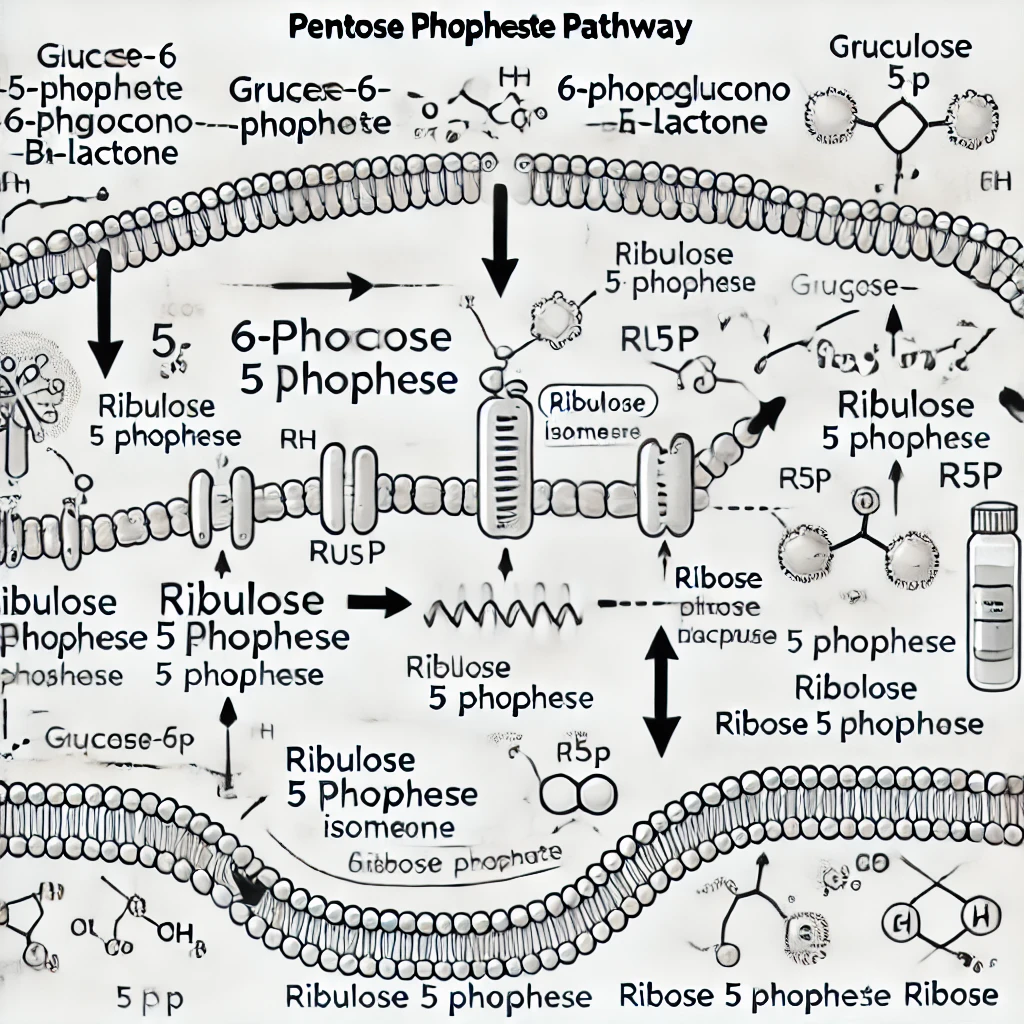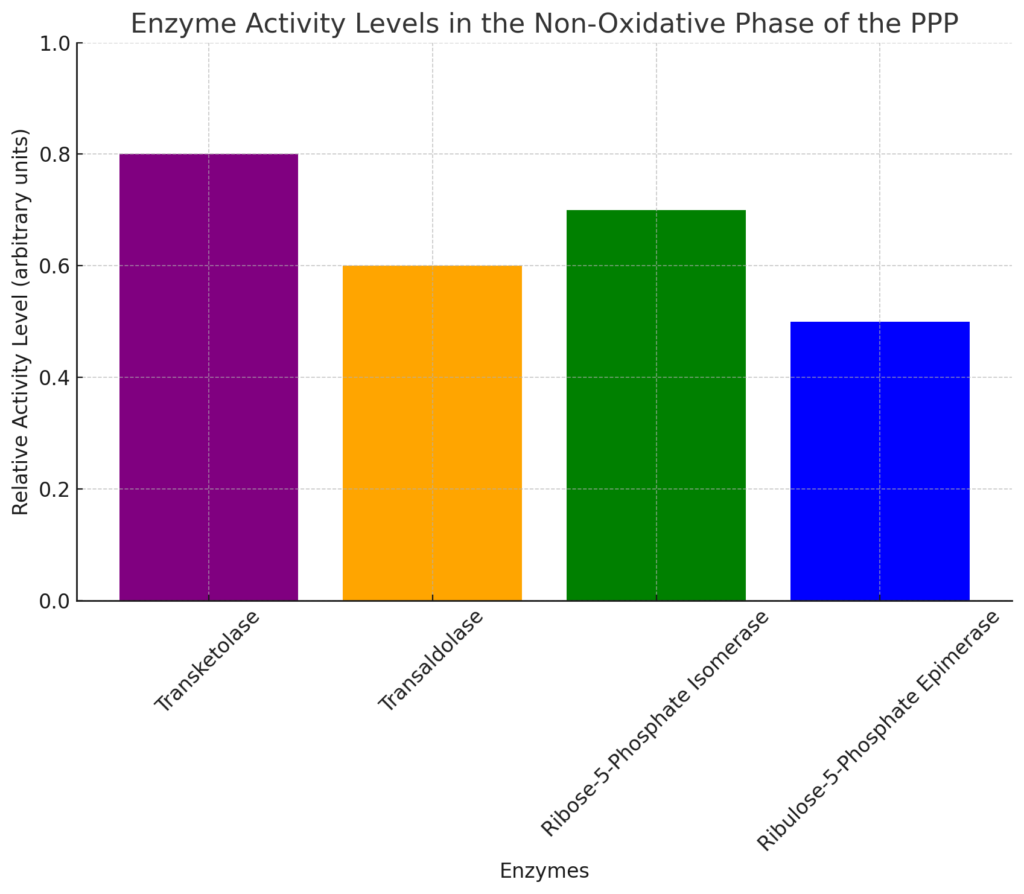Ribulose 5 Phosphate Isomerase: A Comprehensive Overview
Ribulose 5 phosphate isomerase is crucial enzyme involved in the pentose phosphate pathway (PPP), a metabolic pathway parallel to glycolysis. This enzyme catalyzes the reversible conversion between ribulose 5 phosphate (Ru5P) and ribose 5 phosphate (R5P), playing a significant role in cellular metabolism and nucleotide biosynthesis.
The Pentose Phosphate Pathway
The Pentose Phosphate Pathway (PPP), also known as the phosphogluconate pathway or the hexose monophosphate shunt, is a metabolic pathway parallel to glycolysis. It plays a crucial role in cellular metabolism by providing reducing power and biosynthetic precursors. This pathway occurs in the cytosol of cells and is essential for both prokaryotic and eukaryotic organisms.
Below is a diagram of the pentose phosphate pathway and the role of ribulose 5 phosphate isomerase:

Figure 1: The pentose phosphate pathway, illustrating the conversion of ribulose 5 phosphate to ribose 5 phosphate.
Phases of the Pentose Phosphate Pathway
The PPP can be divided into two distinct phases: the oxidative phase and the non-oxidative phase. Each phase has specific enzymes and functions that contribute to the overall pathway.
Oxidative Phase
The oxidative phase of the PPP is primarily responsible for generating NADPH and converting glucose-6-phosphate into ribulose-5-phosphate. This phase consists of a series of enzymatic reactions that lead to the production of key metabolites.
- Glucose-6-Phosphate to 6-Phosphoglucono-δ-lactone
- Enzyme: Glucose-6-Phosphate Dehydrogenase
- Function: This reaction is the first step of the oxidative phase and involves the dehydrogenation of glucose-6-phosphate. The enzyme catalyzes the reduction of NADP+^++ to NADPH, which is vital for reductive biosynthetic reactions and antioxidant defense mechanisms.
- 6-Phosphoglucono-δ-lactone to 6-Phosphogluconate
- Enzyme: Lactonase
- Function: This enzyme catalyzes the hydrolysis of 6-phosphoglucono-δ-lactone into 6-phosphogluconate, facilitating the progression of the pathway.
- 6-Phosphogluconate to Ribulose-5-Phosphate
- Enzyme: 6-Phosphogluconate Dehydrogenase
- Function: This reaction results in the oxidative decarboxylation of 6-phosphogluconate to ribulose-5-phosphate. During this step, another molecule of NADP+^++ is reduced to NADPH, and a molecule of CO2_22 is released.
Non-Oxidative Phase
The non-oxidative phase of the PPP is responsible for the interconversion of sugar phosphates, allowing cells to adapt to varying metabolic needs by producing ribose-5-phosphate for nucleotide synthesis and glycolytic intermediates.
- Ribulose-5-Phosphate to Ribose-5-Phosphate
- Enzyme: Ribulose-5-Phosphate Isomerase
- Function: This enzyme catalyzes the isomerization of ribulose-5-phosphate to ribose-5-phosphate, which is essential for nucleotide and nucleic acid synthesis.
- Xylulose-5-Phosphate to Sedoheptulose-7-Phosphate
- Enzyme: Transketolase
- Function: Transketolase transfer of a two-carbon unit from xylulose-5-phosphate to ribose-5-phosphate, forming sedoheptulose-7-phosphate and glyceraldehyde-3-phosphate. Transketolase is crucial for the rearrangement of carbon skeletons.
- Sedoheptulose-7-Phosphate to Glyceraldehyde-3-Phosphate
- Enzyme: Transaldolase
- Function: Transaldolase transfers a three-carbon unit, linking the PPP to glycolysis by producing glyceraldehyde-3-phosphate and erythrose-4-phosphate from sedoheptulose-7-phosphate.
Key Enzymes and Reactions in the Oxidative and Non-Oxidative Phases of the Pentose Phosphate Pathway:
Table: Key Reactions in the Pentose Phosphate Pathway
| Reaction | Enzyme | Function |
| Glucose-6-Phosphate to 6-Phosphoglucono-δ-lactone | Glucose-6-Phosphate Dehydrogenase | NADPH production, oxidative phase |
| 6-Phosphoglucono-δ-lactone to 6-Phosphogluconate | Lactonase | Hydrolysis, oxidative phase |
| 6-Phosphogluconate to Ribulose 5 Phosphate | 6-Phosphogluconate Dehydrogenase | NADPH production, oxidative phase |
| Ribulose 5 Phosphate to Ribose 5 Phosphate | Ribulose 5 Phosphate Isomerase | Isomerization, non-oxidative phase |
Importance of the Pentose Phosphate Pathway
The PPP serves several critical functions in cellular metabolism:
- NADPH Production: NADPH generated in the oxidative phase is essential for reductive biosynthesis, such as fatty acid and cholesterol synthesis, and for maintaining the redox balance within cells by regenerating reduced glutathione.
- Ribose-5-Phosphate Generation: This sugar is a precursor for nucleotide synthesis, necessary for DNA and RNA production, particularly in rapidly dividing cells.
- Metabolic Flexibility: The non-oxidative phase provides intermediates that can enter glycolysis or gluconeogenesis, allowing cells to adjust their metabolic output based on their needs.
Role in the Pentose Phosphate Pathway
The pentose phosphate pathway is broken into two phases: oxidative and non-oxidative. Ribulose 5 phosphate isomerase is involved in the non-oxidative phase, which generates ribose 5 phosphate for nucleotide biosynthesis and erythrose 4 phosphate for aromatic amino acid synthesis. The non-oxidative phase can be summarized as follows:
- Conversion of Ribulose 5 Phosphate to Ribose 5 Phosphate: Catalyzed by ribulose 5 phosphate isomerase, this step is vital for providing ribose 5 phosphate for DNA and RNA synthesis.
- Interconversion of Sugar Phosphates: Other enzymes such as transketolase and transaldolase further process the sugar phosphates, linking the PPP to glycolysis.
Enzyme activity levels in the non-oxidative phase of the pentose phosphate pathway (PPP)
The non-oxidative phase of the pentose phosphate pathway (PPP) involves several enzymes that catalyze the reversible reactions interconverting sugars. Here’s a list of the key enzymes involved in this phase and their roles:
- Transketolase:
- Function: Transketolase Transfers a two-carbon unit from a ketose donor to an aldose acceptor.
- Substrates/Products: Converts xylulose-5-phosphate and ribose-5-phosphate to glyceraldehyde-3-phosphate and sedoheptulose-7-phosphate.
2. Transaldolase:
- Function: Transfers a three-carbon unit from sedoheptulose-7-phosphate to glyceraldehyde-3-phosphate.
- Substrates/Products: Produces erythrose-4-phosphate and fructose-6-phosphate.
3. Ribose-5-Phosphate Isomerase:
- Function: Converts ribose-5-phosphate to ribulose-5-phosphate.
- Substrates/Products: Interconverts ribose-5-phosphate and ribulose-5-phosphate.
4. Ribulose-5-Phosphate Epimerase:
- Function: Converts ribulose-5-phosphate to xylulose-5-phosphate.
- Substrates/Products: Interconverts ribulose-5-phosphate and xylulose-5-phosphate.
5. Glycolytic Intermediates:
- Function: The non-oxidative phase ends with intermediates that can enter glycolysis, such as fructose-6-phosphate and glyceraldehyde-3-phosphate.
Chart Visualization
Here is a chart that represents enzyme activity levels in the non-oxidative phase of the PPP. We used synthetic data to illustrate how these enzymes might be active under typical cellular conditions.
Enzyme Activity Levels
- X-Axis: Enzymes in the non-oxidative phase.
- Y-Axis: Relative enzyme activity level (arbitrary units).

Here is a bar chart depicting the enzyme activity levels in the non-oxidative phase of the pentose phosphate pathway (PPP). Each bar represents the relative activity level of one of the key enzymes involved in this phase:
- Transketolase: High activity level, reflecting its crucial role in transferring carbon units.
- Transaldolase: Moderate activity level, involved in converting sugar phosphates.
- Ribose-5-Phosphate Isomerase: Significant activity level, indicating its role in interconverting pentose phosphates.
- Ribulose-5-Phosphate Epimerase: Lower activity level compared to others, but still essential for the pathway’s function.
This chart provides a visual summary of the relative contributions of each enzyme to the non-oxidative phase of the PPP.
Key Enzymes and Their Functions in the Non-Oxidative Phase of the Pentose Phosphate Pathway:
Table: Reactions in the Non-Oxidative Phase
| Reaction | Enzyme | Function |
| Ribulose 5 Phosphate to Ribose 5 Phosphate | Ribulose 5 Phosphate Isomerase | Isomerization for nucleotide synthesis |
| Xylulose 5 Phosphate to Sedoheptulose 7 Phosphate | Transketolase | Carbon transfer for sugar rearrangement |
| Sedoheptulose 7 Phosphate to Glyceraldehyde 3 Phosphate | Transaldolase | Carbon transfer linking PPP to glycolysis |
Function and Mechanism of Ribulose 5 Phosphate Isomerase
The primary function of ribulose 5 phosphate isomerase is to facilitate the interconversion of ribulose 5 phosphate to ribose 5 phosphate. This reaction is essential for producing ribose sugars required for nucleotide and nucleic acid synthesis.
Chemical Reaction: The isomerization reaction can be represented as follows:
Ribulose 5 Phosphate (Ru5P)⇌Ribose 5 Phosphate (R5P)
This reaction is an aldose-ketose isomerization, where the enzyme facilitates the conversion by forming an enediol intermediate, which rearranges the molecular structure of the sugar.
Chart: Enzyme Kinetics of Ribulose 5-Phosphate Isomerase

Figure 3: Enzyme kinetics curve for ribulose 5 phosphate isomerase, showing how the reaction rate increases with substrate concentration.
The Role of Ribulose 5-Phosphate Isomerase in the Pentose Phosphate Pathway and Its Implications for Disease
Ribulose 5-phosphate isomerase is an enzyme primarily involved in the pentose phosphate pathway, a metabolic pathway parallel to glycolysis. While the enzyme itself is not directly linked to any specific disease, the pathway it participates in is crucial for several cellular processes. However, imbalances or disruptions in this pathway can have implications for various health conditions. Here are some diseases and conditions that might be indirectly associated with the pathway in which ribulose 5-phosphate isomerase functions:
Diseases and Conditions Related to the Pentose Phosphate Pathway
- Relevance: The pentose phosphate pathway is important for producing ribose sugars necessary for nucleic acid synthesis and for generating NADPH, which is critical for biosynthetic reactions and maintaining redox balance in cells. Cancer cells often exhibit increased activity in this pathway to support rapid growth and proliferation.
2. Diabetes:
- Relevance: Oxidative stress, which is influenced by the balance of NADPH, plays a role in the complications of diabetes. The pentose phosphate pathway helps manage oxidative stress through NADPH production.
3. Neurodegenerative Diseases:
- Relevance: Oxidative stress is a contributing factor in diseases such as Alzheimer’s and Parkinson’s. The pentose phosphate pathway, by generating NADPH, helps protect cells from oxidative damage, potentially influencing the progression of these diseases.
4. Hemolytic Anemia:
- Relevance: This condition can arise due to deficiencies in the pentose phosphate pathway, particularly involving glucose-6-phosphate dehydrogenase (G6PD), another enzyme in the pathway. While not directly related to ribulose 5-phosphate isomerase, the overall pathway’s efficiency impacts red blood cell survival.
5. Inherited Metabolic Disorders:
- Relevance: Although rare, mutations affecting enzymes in the pentose phosphate pathway could potentially lead to metabolic disorders. While ribulose 5-phosphate isomerase deficiencies are not well-documented, similar enzymatic deficiencies can have metabolic consequences.
Importance in Research and Medicine
- Drug Targets: Components of the pentose phosphate pathway, including enzymes like ribulose 5-phosphate isomerase, can be potential targets for drug development, especially in cancer therapy, where pathway modulation might inhibit tumor growth.
- Biomarkers: Changes in the activity of the pentose phosphate pathway enzymes may serve as biomarkers for certain diseases, aiding in diagnosis and monitoring.
Overall, while ribulose 5-phosphate isomerase itself is not directly associated with specific diseases, its role in the pentose phosphate pathway connects it to various physiological and pathological processes. Understanding its function and regulation can have important implications in medical research and treatment strategies.
Significance of Ribulose 5-Phosphate Conversion to Ribose 5-Phosphate in High-Nucleotide Demand Tissues and Rapidly Dividing Cells:
The conversion of ribulose 5 phosphate to ribose 5 phosphate is crucial for rapidly dividing cells, which require a significant amount of nucleotides for DNA and RNA synthesis. This process is particularly significant in tissues with high rates of nucleotide synthesis, such as the liver, adipose tissue, and cancer cells.
Clinical Relevance
Deficiencies in ribulose 5 phosphate isomerase activity can lead to metabolic disorders, impacting the body’s ability to synthesize nucleotides efficiently. Understanding this enzyme’s function is crucial for diagnosing and treating conditions related to impaired nucleotide biosynthesis.
Structural Insights
Ribulose 5 phosphate isomerase belongs to the family of isomerases, known for their ability to catalyze structural rearrangements within molecules. The enzyme’s structure typically comprises a central beta-sheet flanked by alpha-helices, forming a barrel-shaped active site.
Active Site Dynamics
The active site of ribulose 5 phosphate isomerase accommodates the phosphate group of Ru5P, stabilizing the enediol intermediate. This precise arrangement ensures efficient catalysis and specificity for the substrate.
Comparative Analysis: Ribulose 5 Phosphate Isomerase vs. Ribose 5 Phosphate Isomerase
The terms ribulose 5 phosphate isomerase and ribose 5 phosphate isomerase are sometimes used interchangeably, referring to the same enzyme responsible for the isomerization reaction. The naming variation highlights the substrate (Ru5P) and product (R5P) of the reaction.
Table: Enzyme Properties
| Property | Ribulose 5 Phosphate Isomerase |
| Enzyme Classification | EC 5.3.1.6 |
| Molecular Weight | ~25 kDa |
| Optimal pH | 7.5 to 8.5 |
| Cofactors | None required |
Recent Advances and Research
Recent studies have focused on elucidating the detailed kinetics and regulation of ribulose 5 phosphate isomerase. Advanced techniques in structural biology, such as X-ray crystallography and NMR spectroscopy, have provided insights into the enzyme’s conformational changes during catalysis.
Potential for Therapeutic Targeting
Given its role in nucleotide biosynthesis, ribulose 5 phosphate isomerase is a potential target for therapeutic intervention in cancer treatment. Inhibitors designed to modulate this enzyme’s activity could selectively impact rapidly proliferating tumor cells.
Conclusion
Ribulose 5 phosphate isomerase is a pivotal enzyme in cellular metabolism, facilitating the conversion between ribulose 5 phosphate and ribose 5 phosphate. Its function in the pentose phosphate pathway underscores its importance in nucleotide synthesis and overall metabolic regulation. Continued research on this enzyme holds promise for advancing our understanding of cellular biochemistry and developing novel therapeutic strategies.
